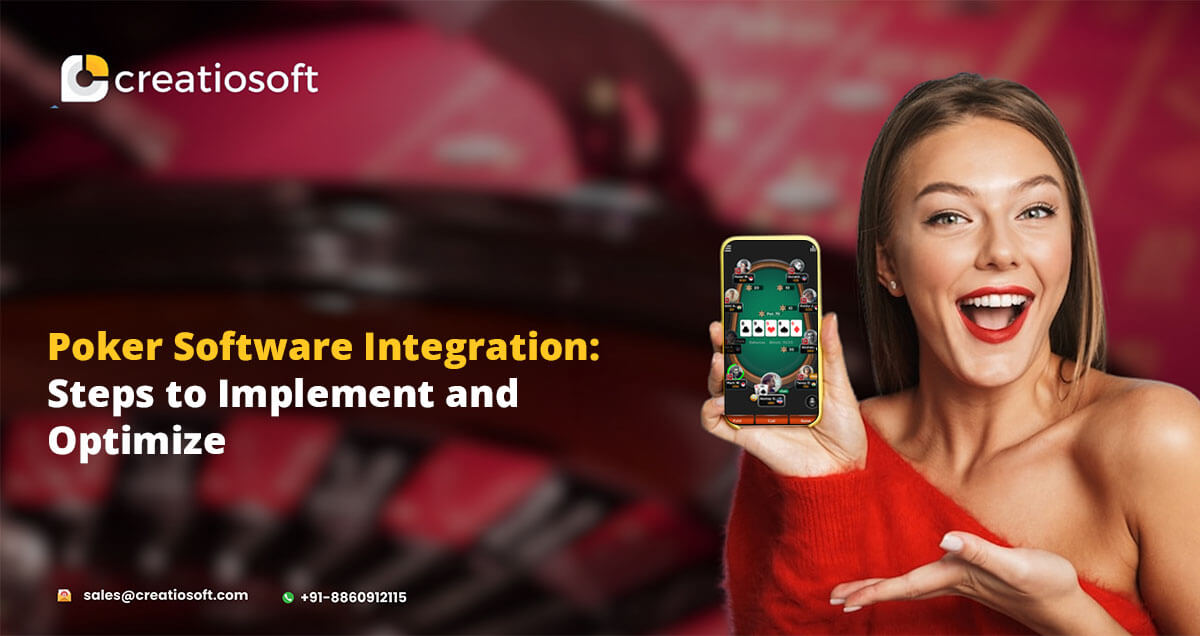The rise of online gaming has boosted the popularity of poker, with many events offering exciting and immersive content. For poker game developers and operators, a strong integration of poker software is crucial to provide players with a clean and enjoyable game. This dedicated blog will discover the essential steps to enhance and optimize poker software system integration, using key concepts and unique practices to ensure your poker platform remains proud in the competitive marketplace.
Understanding Poker Game Integrations
Poker game integration involves combining software components into an integrated system that helps online poker games. It integrates game engines, toll gateways, security systems, human interfaces, and backend systems. The goal is to create a simple and effective mechanism that increases player enjoyment and optimizes the performance of the platform.
Importance of Poker Software Integration
- Enhanced user experience: The seamless integration assures that players enjoy clean, smooth gameplay without interruptions or technical issues.
- Operational efficiencies: Proper integration simplifies backend processes, making it easier for administrators to manage video games, manage productivity and manage communications.
- Safety and Fairness: Integrating strong safety features with fair play algorithms is critical to creating and maintaining player approval.
- Scalability: A properly integrated gadget can handle advanced visitors and gaming versions, allowing the platform to adapt and increase its services.
Steps to Implement Poker Software Integration
1. Define Your Requirements
Before starting the integration process, it’s essential to clearly define your requirements. This includes identifying the specific features and functionalities you want to incorporate into your poker platform. Consider factors such as:
- Game Variants: Determine which poker variants (e.g., Texas Hold’em, Omaha, Seven-Card Stud) you want to offer.
- User Interface: Decide on the design and layout of your poker tables, lobbies, and player profiles.
- Payment Systems: Choose the payment gateways and methods to support deposits and withdrawals.
- Security Protocols: Outline the security measures to protect player data and ensure fair gameplay.
2. Choose the Right Poker Software Provider
Selecting a reliable poker software provider is crucial for successful integration. Look for providers with a proven track record, comprehensive features, and excellent customer support. Key considerations when choosing a provider include:
- Reputation and Reviews: Research the provider’s reputation in the industry and read reviews from other operators.
- Customization Options: Ensure the software can be customized to match your brand and specific requirements.
- Technical Support: Opt for a provider that offers 24/7 technical support to address any issues promptly.
- Compliance: Verify that the software complies with relevant gaming regulations and standards.
3. Plan the Integration Process
A well-structured integration plan is essential to ensure a smooth and efficient process. Create a detailed roadmap that outlines the steps and timelines for each phase of the integration. Key components of the integration plan include:
- Project Timeline: Set realistic deadlines for each stage of the integration process.
- Resource Allocation: Assign tasks to team members based on their expertise and availability.
- Milestones and Deliverables: Define clear milestones and deliverables to track progress and ensure timely completion.
4. Develop and Customize the Software
Once you have a plan in place, it’s time to develop and customize the software. This involves working closely with your chosen software provider to ensure the software meets your specific requirements. Key steps in this phase include:
- UI/UX Design: Design the user interface and user experience to create an engaging and intuitive platform.
- Feature Development: Develop and integrate the desired features and functionalities, such as game variants, payment systems, and security protocols.
- Testing and Quality Assurance: Conduct thorough testing to identify and fix any bugs or issues. This includes functional testing, performance testing, and security testing.
5. Implement Security Measures
Security is a critical aspect of poker software integration. Implement robust security measures to protect player data, prevent fraud, and ensure fair gameplay. Key security measures include:
- Encryption: Use advanced encryption techniques to protect sensitive data during transmission and storage.
- Fraud Detection: Implement fraud detection algorithms to identify and prevent fraudulent activities.
- Fair Play Algorithms: Use random number generators (RNGs) and other fair play algorithms to ensure the fairness of the games.
- Compliance: Ensure your platform complies with relevant gaming regulations and standards.
6. Integrate Payment Systems
Integration of reliable and secure payment systems is essential for businesses to run smoothly and successfully. Choose payment gateways that support a variety of payment methods such as credit cards, e-wallets, and cryptocurrencies. Key payment adjustment considerations include:
- Security: Ensure the payment systems use advanced security measures to protect transactions and player data.
- User Experience: Choose payment gateways that offer a seamless and user-friendly experience.
- Compliance: Ensure the payment systems comply with relevant financial regulations and standards.
7. Launch and Monitor
Once the integration is complete, it’s time to launch your poker platform. Conduct a soft launch to test the platform with a small group of users, and gather feedback. Make any necessary changes based on feedback before you start at all. Key steps during the launch include:
- Soft Launch: Launch the platform with a small group of users to test its performance and gather feedback.
- Marketing and Promotion: Develop a marketing and promotion strategy to attract players to your platform.
- Continuous Monitoring: Monitor the platform’s performance and user feedback continuously to identify and address any issues promptly.
Optimizing Poker Software Integration
1. Monitor Performance Metrics
Regularly monitor key performance metrics to evaluate the success of your poker software integration. Important metrics to track include:
- User Engagement: Monitor player activity and engagement levels to identify trends and preferences.
- Transaction Volumes: Track transaction volumes to ensure the payment systems are functioning efficiently.
- System Performance: Monitor system performance, including server uptime, response times, and load handling capacity.
2. Gather User Feedback
Gathering user feedback is crucial for optimizing your poker platform. Use surveys, feedback forms, and social media channels to collect feedback from players. Key areas to focus on include:
- User Experience: Identify areas where the user experience can be improved.
- Feature Requests: Gather feedback on desired features and functionalities.
- Bug Reports: Collect reports on any bugs or issues players encounter.
3. Implement Regular Updates
Regular updates are essential to keep your poker platform competitive and engaging. Develop a schedule for releasing updates that include new features, bug fixes, and performance improvements. Key considerations for updates include:
- New Features: Regularly introduce new features and game variants to keep players engaged.
- Bug Fixes: Address any bugs or issues promptly to ensure a smooth and enjoyable gaming experience.
- Performance Improvements: Continuously optimize system performance to handle increased traffic and enhance user experience.
4. Stay Compliant with Regulations
The online gaming industry is heavily regulated, and staying compliant with relevant regulations is crucial for the success of your poker platform. Regularly review and update your platform to ensure it complies with the latest gaming regulations and standards. Key compliance considerations include:
- Licensing: Ensure your platform is licensed and complies with relevant gaming authorities.
- Data Protection: Implement measures to protect player data and comply with data protection regulations.
- Fair Play: Ensure your platform adheres to fair play standards and regulations.
Conclusion
Implementing and optimizing poker software program integration is a complicated but important process for you to build a successful on line poker platform. By following these steps and fine practices, you may make certain a continuing and green integration that enhances the player enjoy, ensures operational performance, and maintains your platform competitive in on-line gaming inside the ever-developing enterprise Whether you are a new entrepreneur or trying to replace your existing platform, Well-done poker software program integration gets you on the street to achievement in the dynamic global of on line poker.









